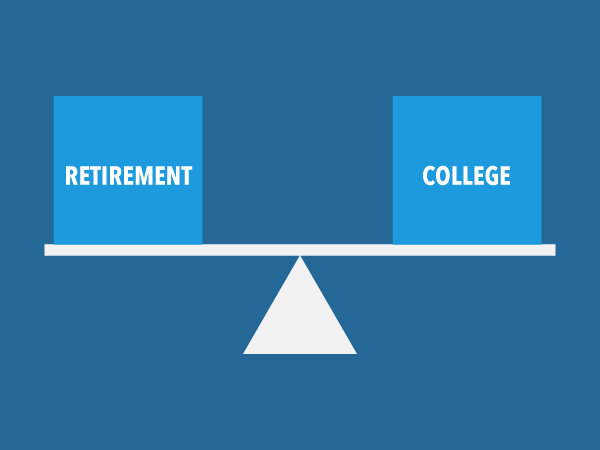For parents, deciding how much to save for retirement versus what to set aside for a child’s education can be a difficult balancing act. Saving for your future should be a priority, particularly through maximizing the benefits of retirement plans. But, although paying yourself first is essential, that doesn’t mean you can’t set funds aside to further a child’s education. A college savings plan is a tax-advantaged way to achieve this goal. The following information is intended to help you understand how these savings vehicles can help you meet the present and future needs of your family.
Why Prioritize Retirement Savings?
To answer this question, two financial planning components should be compared: funding sources and cost variability.
Funding sources. Where will you get the money to pay for your retirement? For most retirees, social security and personal savings represent the main sources of income. The limited number of funding options highlights the importance of personal savings. Without placing a focus on saving throughout your adult life, you may jeopardize the security of your retirement.
Students, on the other hand, can obtain college funding from a number of widely available sources. If family resources (such as a college savings account) aren’t available, students can seek financial aid, federally guaranteed student loans, grants, and scholarships. These vehicles have unique benefits and tradeoffs, but they can be expected to provide accessible options for paying for college.
Cost variability. Educational expenses are much more variable than retirement costs. Although inflation drives up both types of expenses over the years, students have a wide range of pricing options. They can take advantage of the large cost differences between public versus private universities and in-state versus out-of-state institutions. Online degrees can also be considered.
Retirees won’t have the same flexibility without making sacrifices to their desired lifestyle, especially regarding housing and leisure activities. Health care costs, which typically rise in the retirement years, are difficult to control. All in all, given the unpredictability of retirement expenses, you may face some challenging choices in the future if you don’t have sufficient savings.
The reality. Once you leave the workforce, your financial options may be limited. In contrast, your family should be able to combine a variety of funding sources to pay for college. So, while you may relish the idea of fully funding a child’s education, doing so might not be the wise choice.
Balancing Savings Needs
Fortunately, the advantages of retirement plans and college savings plans make it possible to balance your financial priorities. Let’s look at some of the unique features of these plans.
Retirement plans. Putting the maximum possible into your retirement accounts is ideal, especially if your employer offers a matching contribution. That can add up to a substantial amount of extra income. In addition to the tax-deferral benefits, an IRA or 401(k) account can work well to complement your college savings goals in the following ways:
- As related to the Free Application for Federal Student Aid (FAFSA), retirement accounts are considered noncountable assets, so they don’t affect a student’s aid eligibility.
- With an IRA, early withdrawals can be made for qualified educational expenses. The standard 10 percent penalty does not apply, although these distributions will be taxed. (This feature does not apply to 401(k)s.)
College savings plans. A college savings plan is a great way to save and pay for college. What type is best? That depends on your situation, but 529 plans are popular for many reasons, including the following:
- Earnings grow on a tax-deferred basis. Many 529 plans have large contribution limits compared with other college savings plans, so the tax advantages could be significant.
- Distributions are not subject to federal taxes when used for qualified education expenses.
- Many states offer state income tax deductions for contributions.
- Qualified higher education expenses include (but are not limited to) tuition and room and board, books, computers, and supplies.
- Since 2018, federal guidelines include up to $10,000 annually in K–12 tuition as a qualified education expense. But the tax rules for K–12 withdrawals vary by state, so be sure to check your state’s rules regarding this benefit.
- Since 2019, qualified expenses include certain student loan repayments up to a lifetime limit of $10,000 for the 529 account beneficiary and for each of the beneficiary’s siblings.
- A “front-loaded” contribution of up to five years’ worth of the annual exclusion gift of $15,000 (for a total of up to $75,000) can be made. This feature is unique to 529 plans.
You’ll also want to consider the impact of 529 plans on student financial aid. Often, it’s minimal. Here are some details to keep in mind:
- Plans owned by parents or dependent students, as well as custodial-owned plans, are considered parental assets. On the FAFSA, they are assessed at a rate of 5.64 percent when determining a family’s expected contribution to tuition costs. Plans owned by independent students are considered student assets, which are assessed at the rate of 20 percent.
- A grandparent-owned 529 account does not count as an asset on the FAFSA. But distributions are reported as untaxed income to the student. That means a student’s financial aid eligibility could be reduced by up to 50 percent of the distribution amount. This downside can be avoided, however, by waiting to use these funds until the last two school years.
Finally, you should be aware that if you withdraw 529 funds for anything other than qualified expenses, the distributions could be subject to tax on the account’s gains, as well as a 10 percent penalty.
Achieving the Right Balance
By putting money aside wisely, it’s possible for parents to help provide for their children’s education without compromising a comfortable retirement lifestyle for themselves. For further guidance on this complex topic, I am at your service.










